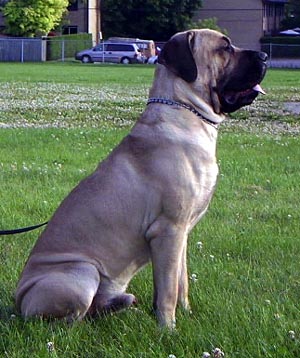INSTANT PROMOTION - LIMITED TIME OFFER - GET YOUR PUPPY COUPON TODAY
Hicksville: 516-938-7877
Lynbrook: 516-825-7877
Hicksville: 516-938-7877
Lynbrook: 516-825-7877
Currently we do not have any Cane Corso Puppies available.
Please complete the form below to be notified when they are back in our stores.

Other Names: Italian Mastiff, Sicilianos Branchiero, Cane di Macellaio, Italian Corso Dog, Italian Molosso
Height: 22 – 28 inches. Weight: 80 – 140 lbs.
Colors: Black, plumb-gray, slate, light gray, light fawn, deer fawn, dark fawn and tubby (very well marked stripes on different shades of fawn and gray). In the fawny and tubby subjects there is a black or grey mask only on the muzzle and shouldn’t go beyond the eye line. A small white patch on the chest, on the feet tips and on the nose bridge is accepted. Coat: Short hair but not smooth, with vitreous texture, shiny, adherent, stiff, very dense, with a light layer that becomes thicker in winter (but never crops up on the covering hair).
Temperament: Cane Corsos are loyal, protective, and don’t drool as much as other mastiffs. They are protective and aloof with strangers, remaining very wary of them. They are excellent guards and watchdogs, and are robust in appearance as well as performance. They are usually quiet, affectionate, and caring of their family, including children. They are very intelligent and keep their eyes on strangers. With Children: Yes, as long as they are socialized. They are caring of children who are in their family, but aloof with strangers. With Pets: Yes, as long as they are socialized.
Watch-dog: High. Cane Corsos make excellent watchdogs. Guard-dog: High. Cane Corsos make excellent guard dogs. They were originally bred to be guards and drivers.
Care and Exercise: Corsos need regular exercise, and are fine with living in the backyard. They should be checked for eye problems and other health concerns. Training: Training is essential for the Corso, otherwise they may become protective and aggressive towards even welcome strangers. They should be trained not to be aggressive around friends and other pets. Socialization is a must when they are puppies. Special Needs: Fenced yard, a leash, socialization and training. Learning Rate: High. Cane Corsos are very intelligent.
Activity: Medium. Living Environment: Cane Corsos need a back yard with a fence at their owner’s house. They need space, since they are a large dog, and require some kind of daily exercise. The best owner for this type of dog would be a guardian dog-experience owner in a rural or suburban home, but they can live in an apartment if given enough exercise.
Health Issues: Hip and elbow dysplasia, gastric torsion (AKA Bloat, or Twisted Stomach), and Demodex Mange (Red mange). Other health concerns include heart disorders, torn cruciates, eyelid abnormalities, Cherry eye, ectropion and entropion.
Life Span: 10 – 11 years. Litter Size:
Country of Origin: Italy (Sicily) History: Cane Corso are direct ancestor to the old Roman Molossian and probably the Neapolitan Mastiff. In the recent past preserved and prevalent in the provinces of Foggia and Ban. Their name derives from the Latin “cohors”, which means “protector, guardian of the farm-yard”, whereas Corso in Italian means “dog”. Originating in the 1600s, the breed was a recreation of an older breed of the Italy, the Cane di Macellaio. It was actually developed on Sicily, not the mainland of Italy. They were used by butchers to drove cattle, guard the farmland and hunt large predators. They may have been used in dog fighting as well. After World War II, like many other breeds, this breed almost died out. Thanks to fans in the 1980s, though, the breed made a comeback to a world which now holds them in high favor.
Class: Working Registries: ARBA, FCI (Group 2), FSS (Foundation Stock Service)